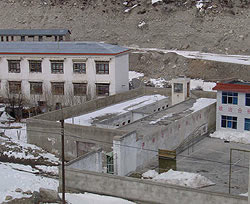
Nyalam Prison
The May 2003 repatriation of 18 Tibetans from Kathmandu to Tibet drew international headlines and condemnation of the Nepalese government. In August, Nepal said that it would not repatriate Tibetans in the future.
The 18 deported Tibetans spent 11 days at a Nyalam prison near the Tibet-Nepal border before being transferred to the “New Reception Center” in Shigatse on June 10, 2003. Former prisoners from Nyalam reported to ICT that the 18 were badly beaten and tortured with electric batons. Prisoners also reported that some of the 18 deported refugees were subjected to even more sadistic torture, such as having sewing needles inserted in between their finger nail and flesh, which in one case was apparently done to revive one of the 18 who was unconscious.
“The worst fears of the international community – that these 18 deportees would be brutally tortured – are coming true,” said John Ackerly, President of ICT.
“We know that international attention has improved the treatment of some prisoners, but international headlines and concern do not seem to have helped these refugees who did nothing more than try to flee to freedom,” Ackerly said.
Former prisoners from Shigatse say that seven of the 18 were still in prison as of the end of September. The name of the new prison, Tibet’s New Reception Center, is ironically similar to the refugee reception centers in both Kathmandu, Nepal, and Dharamsala, India. The literal translation of the signage posted in front of the new prison in Shigatse is “The new reception center in the Snow lands” (Tibetan: khangjong nelenkhang sarpa). Snow lands is a traditional name for Tibet. In Kathmandu, the commonly used name of the refugee reception center administered by the United Nations High Commissioner for Refugees (UNHCR) is the Tibetan Refugee Reception Center (Tibetan: bhoeme kyabjol nelenkhang).
The ‘New Reception Center’ is set off from residential or commercial areas to the southwest of Shigatse across from a marshy area known in Tibetan as Dechen Podrang. Dechen Podrang is the traditional summer residential area for the previous Panchen Lamas and was often used for public religious sermons and blessings.
The facility had been used as housing and office headquarters for a Chinese construction company. The construction company closed two years ago. During the SARS outbreak in the PRC last summer, some of the buildings inside the compound were reportedly used for a short time as an Emergency Epidemic Center, according to local government workers in Shigatse.
According to former inmates, there were approximately 300 prisoners in detention at the New Reception Center in June 2003 and in November there were an estimated 450 to 500. Nearly all of the prisoners are Tibetans who have been caught at the Nangpa pass or near the Friendship Bridge border crossing near Dram, the main commercial border crossing into Nepal from Tibet.
Approximately 2,500 Tibetan refugees escape into exile annually, traveling through Nepal en route to India. Human rights organizations and the UNHCR often only learn of arrests by Chinese border patrols, or of deportations of Tibetan refugees by Nepalese officials, when refugees make a successful re-attempt at escape.
Refugees who are caught coming back from India or Nepal are reportedly treated much more harshly and receive longer sentences than those who are caught trying to leave Tibet, according to former inmates. Tibetans who have served sentences in the New Reception Center or at Nyari prison in Shigatse report that most individuals caught at the border serve a prison sentence of three to five months, receive beatings and torture regularly (most commonly being hit with an electric baton), and must perform hard labor, usually road building in and around Shigatse.
Tibetans detained for trying to flee Tibet without papers are rarely provided with any judicial hearing or proceeding. Reports emerging from the new prison in Shigatse indicate an even more lawless and extra judicial character. Former inmates have told ICT that many prisoners are released after serving three to five months and paying a fine typically ranging from 1,700 to 5,000 yuan or (US$212-625). However, family members often have to pay double the amount of the fines or more in bribes. One relative reported that he had to visit the prison seven times and bribe officials with bottles of liquor and meals before they would accept payment of the fine.
In addition, each prisoner must sign a document that states that they will never again attempt to leave the People’s Republic of China to go to India and family members also have to sign as guarantors that the prisoner will not try to flee again.
“If I left, my relative would have to go to prison in my stead,” said one former prisoner.
The tactic of securing guarantors for former political prisoners has been used by the PSB in Tibet to ensure probationary stipulations are followed, as well as to make certain that former prisoner do not try to flee into exile.
The head of “Tibet’s New Reception Center” is reportedly Chinese and spends little time in Shigatse, while his deputy is a Tibetan from Derge. There are approximately 160 employees at the detention facility, excluding police, army and paramilitary security personnel, former inmates have told ICT. Of the employees, less than 20″ are Tibetans, prisoners say.

